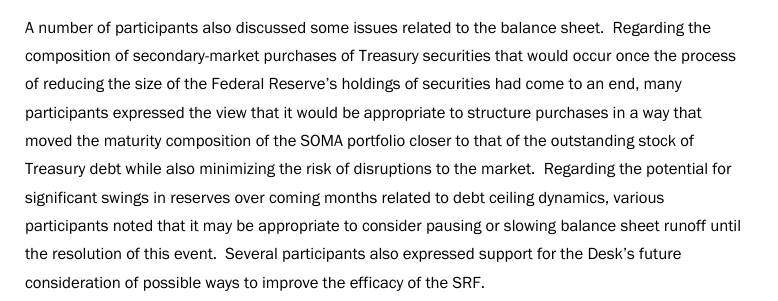This is a segment from the Forward Guidance newsletter. To read full editions, subscribe.
January’s FOMC meeting minutes were released this week, providing plenty of fodder for monetary plumbing nerds to piece together what the Fed thinks about bank reserves and its ongoing campaign of quantitative tightening (QT).
As seen in the chart below, the QT campaign has been fraught with nuance and idiosyncratic offsetting. As QT occurred, the vast majority of it has been offset by the reverse repo facility (RRP) balance as seen by the white line below.
Further, this has been hiccuped by the debt ceiling debacle of 2023 and the SVB banking crisis that led to the bank term funding program’s creation.
All that said, we’re getting close to the end goal of QT in terms of the bank reserve levels the Fed is targeting. There are a lot of ways to measure this, but a simple shorthand is that the Fed has been targeting an ideal reserve level of $3 trillion that includes both bank reserves and the RRP. Currently, that nets us at $3.27 trillion.
Given this context, there’s been a lot of talk about when the Fed might end QT altogether. And with the release of this week’s FOMC meeting minutes, we received our first hint:

Now, there’s a lot to unpack here as it contains a lot of nuances. Let’s run through them:
- The Fed is re-thinking the duration of the bonds it holds. Ideally, it wants to run back to a level of duration that was pre-2008 and pre-QE. That is what they meant by saying “appropriate to structure purchases in a way that moved the maturity composition of the SOMA portfolio closer to that of the outstanding stock of Treasury debt…”
As of right now, that SOMA portfolio is composed of 5% in T-bills. However, treasury issuance is at 22.4%.
- The Fed is concerned about the implications of the debt ceiling and the ensuing treasury general account (TGA) drawdown, as well as the following TGA rebuild once the debt ceiling is resolved. Simply put, for the TGA to be rebuilt back to the level it was before the debt ceiling, Treasury needs to issue a ton of T-bills. In 2023 it was able to do this easily because the RRP was filled to the brim and acted as a dampener for it. Now, sitting at $73 million, there’s no buffer. As such, the following statement was included in the minutes: “Regarding the potential for significant swings in reserves over coming months related to debt ceiling dynamics, various participants noted that it may be appropriate to consider pausing or slowing balance sheet run-off until resolution of this event…”
- Although not a pressing concern, the Fed is getting closer and closer to reserve levels where “liquidity hiccups” tend to happen. The last time this occurred was September 2019 when reserves were too scarce and caused a major repo spike, stopping QT in its tracks. However, looking at the current reserve demand elasticity dashboard below (one of the best metrics for gauging risk of a repo blowup), as long as we are near that zero level there are no short-term concerns. That said, the Fed is aware that time is ticking and it does not want a repeat of September 2019 — hence its mention that “several participants also expressed support for the Desk’s future considerations of possible ways to improve the efficacy of the SRF…” The SRF, or standing repo facility, is a new permanent tool the Fed has in place to act as a shock absorber during events such as in September 2019. By mentioning its aim to improve efficacy, we can surmise that the Fed is focused on ensuring all the correct tools are in place to continue gradual balance sheet run-off.
For a relatively short amount of text, we sure were able to glean a lot as to how the Fed is thinking about its balance sheet and bank reserves in the coming months.
Read the full article here
